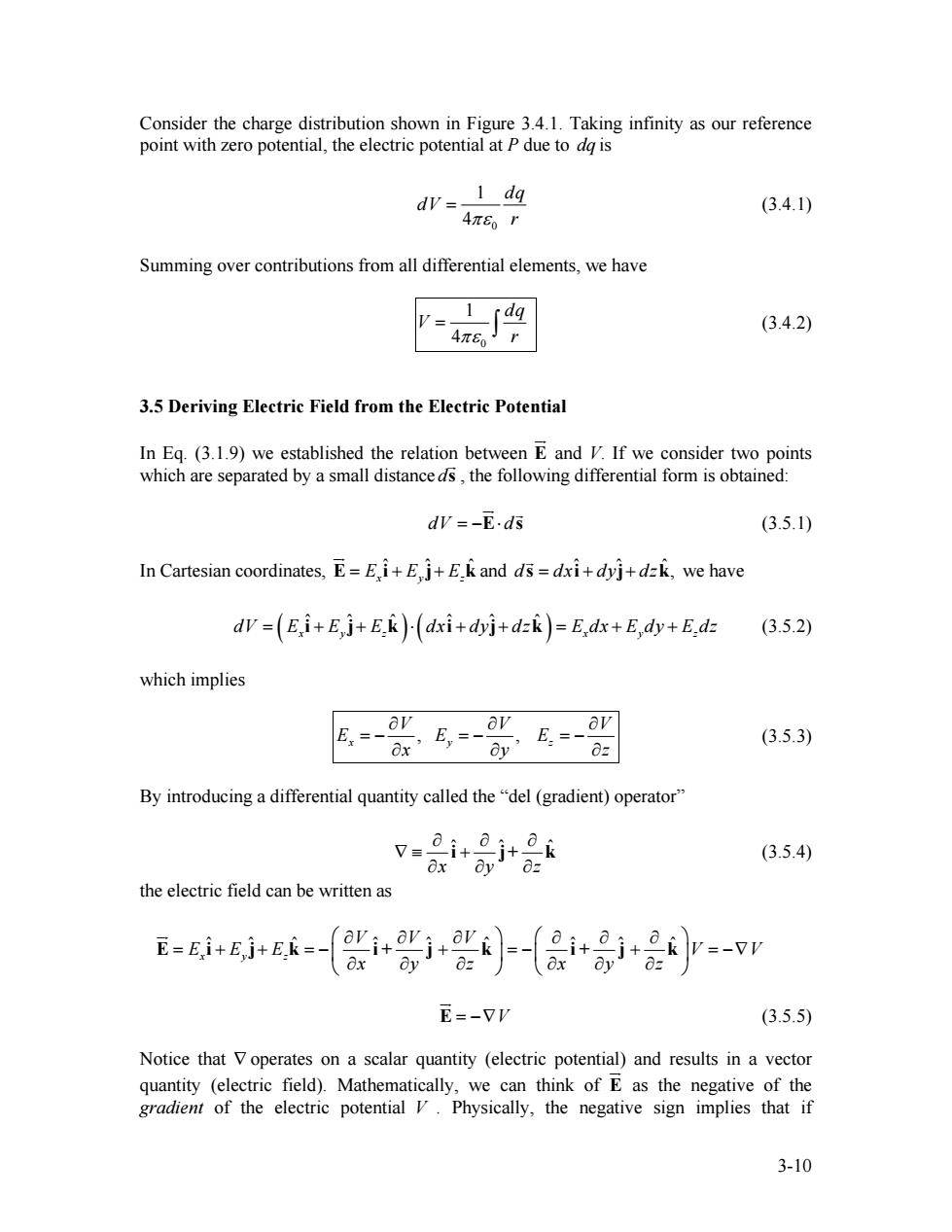正在加载图片...

Consider the charge distribution shown in Figure 3.4.1.Taking infinity as our reference point with zero potential,the electric potential at P due to dg is dv=-1 dq (3.4.1) 4π80r Summing over contributions from all differential elements,we have (3.4.2) 3.5 Deriving Electric Field from the Electric Potential In Eq.(3.1.9)we established the relation between E and V.If we consider two points which are separated by a small distance ds,the following differential form is obtained: dV=-E.ds (3.5.1) In Cartesian coordinates,E=Ei+Ej+E.k and ds=dxi+dyj+dzk,we have dV=(E.i+E,j+E.k)-(dxi+dyj+d=k)=E,dx+E,dy+E.d= (3.5.2) which implies av E ,E,= av Es (3.5.3) Ox Oy 0z By introducing a differential quantity called the"del(gradient)operator" i+jtok (3.5.4) the electric field can be written as ax E=-VV (3.5.5) Notice that V operates on a scalar quantity (electric potential)and results in a vector quantity (electric field).Mathematically,we can think of E as the negative of the gradient of the electric potential V.Physically,the negative sign implies that if 3-10Consider the charge distribution shown in Figure 3.4.1. Taking infinity as our reference point with zero potential, the electric potential at P due to dq is 0 1 4 dq dV πε r = (3.4.1) Summing over contributions from all differential elements, we have 0 1 4 dq V πε r = ∫ (3.4.2) 3.5 Deriving Electric Field from the Electric Potential In Eq. (3.1.9) we established the relation between E JG and V. If we consider two points which are separated by a small distance ds G , the following differential form is obtained: dV = − ⋅ E d s JG G (3.5.1) In Cartesian coordinates, ˆ ˆ ˆ E i =++ E E x y Ez j k JG and ˆ ˆ ˆ d d s i = + x dyj+ dzk, G we have ( ) ( ) ˆ ˆ ˆ ˆ ˆ ˆ xyz x y z dV = + E i j E + E k ⋅ dxi + dyj+ dzk = E dx + E dy + E dz (3.5.2) which implies , , x y z V V E E E V x y z ∂ ∂ = − = − = − ∂ ∂ ∂ ∂ (3.5.3) By introducing a differential quantity called the “del (gradient) operator” ˆ ˆ ˆ x y z ∂ ∂ ∂ ∇ ≡ + ∂ ∂ ∂ i j+ k (3.5.4) the electric field can be written as ˆ ˆ ˆ ˆ ˆ ˆ ˆ ˆ ˆ xyz V V V E E E V V x y z x y z ⎛ ⎞ ∂ ∂ ∂ ⎛ ∂ ∂ ∂ ⎞ =++ = −⎜ ⎟ + = −⎜ + ⎟ = −∇ ⎝ ⎠ ∂ ∂ ∂ ⎝ ∂ ∂ ∂ ⎠ E i j k i + j k i + j k JG E = −∇V JG (3.5.5) Notice that ∇ operates on a scalar quantity (electric potential) and results in a vector quantity (electric field). Mathematically, we can think of E JG as the negative of the gradient of the electric potential V . Physically, the negative sign implies that if 3-10